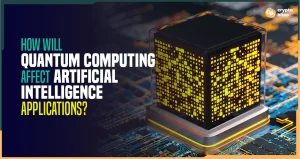
The Future of DeFi: Trends and Innovations to Watch in 2023
With a total value locked (TVL) of $77.296 billion and around 6.68 million users, the decentralized finance (DeFi) market is one of the most rapidly growing sectors of the crypto and blockchain industry. DeFi is still in its infancy, and the next few years will be filled with developments and innovations that will shape its future.
Today, the most common implication of DeFI is decentralized exchanges (DEXs) that allow users to trade cryptocurrency without a central authority. Some examples of these exchanges include PancakeSwap, SushiSwap, and Uniswap.
DeFi users can borrow and lend cryptocurrencies through protocols like MarkerDAO, Aave, and Compound. Likewise, yield farming platforms allow users to stake their cryptocurrency for a percentage of rewards.
While these are the better-known aspects of DeFi, the future holds even more advancements. In this guide, we look at the upcoming DeFi innovations and trends to familiarize yourself with.
DeFi Trends and Innovations of 2023
DeFi’s most pressing tasks for the year will be to stabilize the crypto market for the new wave of investors, introduce new governance models, expand DeFi into traditional finance sectors, and create seamless user experiences. Keeping in line with these anticipations, here are some trends to look out for.
Introduction of Crypto Bridges
A complicated aspect of investing in crypto is blockchain navigation since there are many blockchains in the space, each with its limitations and rules. Investors cannot use coins native to one blockchain on another blockchain. For instance, an investor cannot use the ERC-20 token or Ether on any blockchain other than the Ethereum chain.
The lack of compatibility of blockchains posed a hurdle for investors who want to send crypto from one blockchain to another. That’s where crypto bridges come in.
A crypto bridge lets users send and receive tokens or coins from one blockchain to another, such as Terra to Ethereum and vice versa. Two types of crypto bridges have emerged:
- Trusted Bridges: They are centralized, which means a central party takes custody of the transactions.
- Trustless Bridges: No central party is involved, and the transactions process using trading algorithms and smart contracts.
While crypto bridges are a step forward in cross-chain technology, it’s essential to know their risks too. Trust is an integral component of these transactions. Users who rely on trusted bridges have to trust a third party to hold their funds, inviting a risk of censorship, whereas those using trustless bridges must trust the smart contracts powering the transactions.
However, crypto bridges will undoubtedly improve in the coming years, becoming more ubiquitous and user-friendly.
Expansion Into Traditional Finance Sectors
DeFi has long been transforming business-related financial services, but it was previously limited to small and medium enterprises. Now, larger enterprises and individuals are widely taking up these services.
A notable example is crypto-based loans, which often offer higher yields and have fewer requirements than traditional ones. For instance, Compound Treasury and Coinbase offer USDC-based loans with a 4% yield, much higher than conventional products.
Similarly, many companies now use DeFi exchanges for cross-border remittance by converting payment amounts to USD-pegged stablecoins or making direct payments. The use of DeFi financial services is not limited to the western world. African companies are also dabbling increasingly in this space, adopting new technologies for national and international payments.
For example, Wala and BitPesa are two blockchain-based financial services providing low-cost solutions to African companies, which now use these services as alternatives to conventional money transfer services, such as Western Union and MoneyGram.
2023 will see collaborations between traditional financial services and DeFi to create a cohesive ecosystem that allows users to benefit from the advantages of both. For example, Archblock, a TrueFi (lending protocol) subsidiary, has collaborated with MJL Capital, a hedge fund, to launch a DeFi-based lending product.
An MJL Capital spokesperson has reported that the hedge fund has plenty of banks in its pipeline, ranging in asset size from $500 million to $5 billion.
It’s interesting to note that the transfer of innovation and services is going both ways. DeFi is also adopting financial services and innovations from traditional finance, with tranche lending being a good example. Traditionally, tranche lending products allow lenders to fund risky and volatile loans by sharing the risk with other lenders.
Lending protocols like Saffron Finance and BarnBridge have become the pioneers of tranche lending in the DeFi space, offering innovative products like tranched lending and vaults.
New Governance Models
Governance tokens are at the forefront of revolutionizing DeFi governance, allowing token holders to participate in governing decentralized organizations or protocols. In addition, these tokens enable holders to vote on changes or propose ideas, such as new upgrades and features.
These tokens distribute decision-making power among the community rather than limiting it to a small number of stakeholders. Examples of these tokens include Compund’s COMP token, MakerDAO’s MKR token, and Uniswap’s UNI token. But then again, governance tokens often perpetuate the one-token, one-vote system, which can lead to the centralization of power.
That’s why DeFi organizations are advancing this model by using computational voting systems, such as:
- Quadratic Voting: In this system, voters can purchase votes in which the price of their votes will be a quadratic function of the number of votes they’ve bought. For example, two votes cost four tokens, three cost nine, four cost 16, and so on. The quadratic voting system prevents large token holders from manipulating results in their favor due to the high cost of vote acquisition.
- Limited Governance: In a blog post, Vitalik Buterin proposed the idea of limited governance to constrain governance proposals to particular DeFi parameters. Likewise, DeFi organizations and protocols can also keep time delays between the submission and implementation of ideas, allowing space for reflection so the community can prepare for the proposal’s impact.
- Proof of Participation: Many forward thinkers have proposed to limit governance to account holders who have participated in the DeFi space, such as those who have staked assets or used the protocol services. Such a system will ensure that only active users can partake in decision-making, limiting the risk of governance attacks.
Since the DeFi world is concerned about catastrophic governance attacks and manipulations, stakeholders will introduce more secure and bulletproof governance models shortly.
Synthetic Securities
Synthetic assets are a fast-growing sector in the DeFi space, allowing developers to create synthetic securities that usually trade on traditional exchange networks. For example, a developer can create a synthetic stock of Company XYZ that trades on NASDAQ or the New York Stock Exchange.
For example, users can buy synthetic stocks of Microsoft, Apple, and other companies on the Mirror Protocol. These stocks are tokenized derivatives of real-world assets whose prices they track.
Another similar example is Synthetix, a decentralized protocol where users can trade Synths or synthetic assets that track prices of real-life assets, including commodities, currencies, and stocks. These assets allow users to trade synthetic versions of commodities, such as gold, without purchasing physical gold.
Synthetic securities are a relatively newer concept not as popular as other DeFi trends. But they have high growth potential, especially due to the emerging synthetic funds, which track exchange-traded funds (ETFs), like the Invesco QQQ (QQQ) and SPDR S&P 500 (SPY).
The adoption of synthetic securities is mainly due to their liquidity and borderless ownership transfer. These securities protect holders against censorship since the transactions process on public blockchains. The decentralized nature of these securities also ensures that users don’t have to depend on a centralized party for their transactions and trades.
Intensified Regulation
While we celebrate the trends and innovations in the DeFi space, ignoring the $4.2 billion lost to attacks and hacks so far would be unfair. The dilemma arises when one considers the compromise of decentralization that would occur with third-party intervention in the wake of regulation. But some degree of regulation is also necessary to ensure user trust in the crypto market.
The European Markets in Crypto Assets Regulation (MiCA) framework released by the European Commission will enter its implementation phase in 2023. The EC intends this bill to create a set of rules for activities and services related to crypto assets. Similarly, the World Economic Forum also has a policy-maker toolkit that governments can use to understand and navigate the legal and regulatory side of DeFI.
The full impact of these regulations is yet to be seen and understood. On the one hand, they may help bring more clarity to the DeFi space by reducing some of the risks, while on the other hand, they might carry unwanted bureaucracy and new restrictions.
The Takeaway
Looking at the emerging trends in DeFi, it’s evident that the sector has no plans to slow down innovation. On the contrary, with continued growth and advancements in the space, we can expect to see cross-chain interoperability, synthetic assets, DEX proliferation, and better governance models.
Thus, it’s an exciting time for developers and DeFi enthusiasts alike, opening new routes to explore the full potential of blockchain technology.




